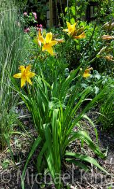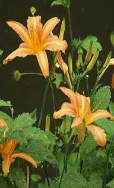Daylily, Hemerocallis secies
Daylily, Hemerocallis dumortieri
The leaves and young shoots can be eaten cooked. They must be consumed when very young or else they become fibrous.
The flowers and flower buds are eaten raw or cooked. The flowers are crisp and juicy with a pleasant sweetness and no unpleasant after-taste.
They can be dried and used as a thickener in soups etc.
The flower buds contain about 43 mg vitamin C per 100g, 983 IU vitamin A and 3.1% protein.
The root is edible raw or cooked.
The juice of the roots is an effective antidote in cases of arsenic poisoning.
The tough dried foliage is plaited into cord and used for making footwear.
Plants form a slowly spreading clump and are suitable for ground cover when spaced about 45cm apart each way. The dead leaves should be left on the ground in the winter to ensure effective cover.
Both this daylily and the H. fulva are happy to grow by ponds and streams, as well as in the rest of the Garden.
Daylily, Hemerocallis fulva
The leaves and young shoots are edible cooked. An asparagus or celery substitute. An excellent sweet tasting vegetable. The leaves need to be eaten whilst still very young since they quickly become fibrous.
The flowers are edible raw or cooked. The petals are thick and crunchy, making very pleasant eating raw, with a nice sweetness at the base because of the nectar.
The flowers can also be dried and used as a thickener in soups etc. In this case, they are picked when somewhat withered and closed. A rich source of iron.
Flower buds can be eaten raw or cooked. A pea-like flavour. They can also be dried and used as a relish.
The dried flower contains about 9.3% protein. 25% fat!?, 60% carbohydrate (rich in sugar), 0.9% ash. It is rich in vitamin A.
The tubers can be eaten raw or cooked. A nutty flavour. Young tubers are best, though the central portion of older tubers is also good.
An extract of the flowers is used as a blood purifier.
The rhizome is used in Korea to treat jaundice, constipation and pneumonia.
The juice of the roots is an effective antidote in cases of arsenic poisoning.
The root also has a folk history of use in the treatment of cancer - extracts from the roots have shown antitumour activity.
The tough dried foliage is plaited into cord and used for making footwear.
Plants form a spreading clump and are suitable for ground cover when spaced about 90cm apart each way. The dead leaves should be left on the ground in the winter to ensure effective cover.
